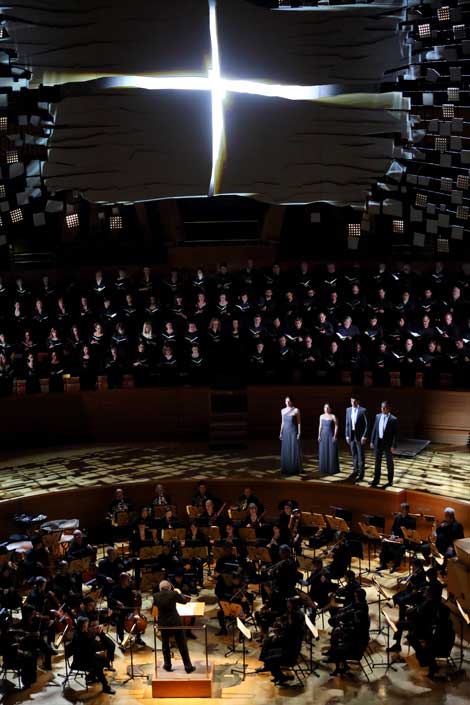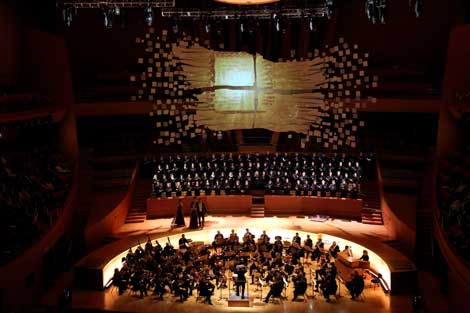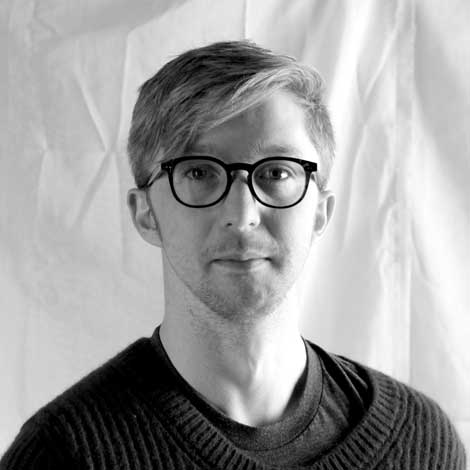There were moments in the recent James Darrah directed production of the Los Angeles Philharmonic performance of the Beethoven Missa Solemnis, conducted by Michael Tilson-Thomas (a co-production with the San Francisco Symphony, in celebration of Tilson-Thomas’ 70th birthday; and the second production in the LA Philharmonic’s in/SIGHT series, featuring dramatic visuals fully integrated with the orchestral performances), when the occasionally convoluted trajectory of Beethoven’s magnificent score seemed to intersect with the architecture of places far from Disney Hall or even the architecture of the music itself. This almost certainly had something to do with the video projections devised by Finn Ross.
Finn Ross has produced video works for many operatic and choral music productions; but his most notable work to date dealt more specifically with the intersections of that most interior of spaces with the spatial architecture of real places. In The Curious Incident of the Dog in the Night-Time, the production design and in particular, Ross’ video projections (for which Ross won an Olivier Award) turn the main character, Christopher’s, cerebral space inside out, as he negotiates his way between the verbal, linguistic domain of concrete communications and abstract ideas, and the bewilderment of public spaces (like Paddington Station). There in Disney Hall, as the text segued from “Kyrie” to “Gloria,” vaulted cloisters on the screen dissolved into the textual fragments, and the words themselves into showers of letters eliding into shooting stars.
It might be said that Ross, who is affiliated with the Mesmer production house in London, has made a specialty of exploding such “black boxes” within the “black box” of the theater. He spoke with Artillery last November from Vienna, preparing video for yet another operatic production, having only recently collaborated with the Metropolitan Opera on its production of John Adams’ The Death of Klinghoffer.

From the Missa Solemnis performance at Walt Disney Concert Hall on January 9,
courtesy Mathew Imaging.
ARTILLERY: Had you worked in America before these productions?
FINN ROSS: I’d worked with Simon McBurney on a 2008 production of All My Sons. I had a few shows at the Lincoln Center Festival; and various American tours. The production of Shun-kin we did for the Lincoln Center Festival was a beautiful thing—a career highlight. I was also very proud to be a part of The Death of Klinghoffer at the Met.
The Missa Solemnis is one of Beethoven’s greatest works, but it’s also his most unusual and in certain ways least characteristic. How have you been approaching it?
It’s been interesting in that it’s not a piece of music that lends itself to visual painting the way a theatrical piece would. In terms of the music itself, there’s an incredible musical knowledge involved, which I don’t have. Michael Tilson-Thomas really does have it, though, which was invaluable in guiding us through it. It was quite a long process moving backwards and forwards through it; using the key changes to heighten the tension, translating it into physical expression, creating a 3D world. It’s not a storytelling piece. Everything I normally do is about telling stories. It’s a figurative process. Text is the big thing. There are the repeated lines, and then parts not repeated—all within this vast musical framework.
The design we worked with was not intended to reflect the Gehry architecture of Disney Hall. It had to work for Davies Hall in San Francisco, as well [where it will be performed in June, with Tilson-Thomas conducting the San Francisco Symphony]. We were working with an oval shape for the visuals. The physical makeup of the space was shaped by James Darrah with set design by his [Studio] Chromatic team. [This included Cameron Jaye Mock and Emily Anne MacDonald.]
It’s different from watching a play. There’s no through-line or narrative thread representative of that drama. It’s much more meditative and contemplative. It was informed by many conversations with Michael. We were developing it both musically and musicologically, translating it into a dense poetry with Michael.
Are you planning one more or less seamless projection, or will the video/projections shift dramatically with each part from Kyrie to Agnus Dei?
Without the narrative thread, each movement has to have its own space, plan, architecture, images. Some sections have no video. I [was] working in collaboration with [lighting designer] David Finn. It’s conceived as a live experience, not an oratorio, with the singers moving around; but equally not a piece of theater. These are not character voices, but voices delivering the same message, switching and changing among them—this alternation of praise and prayer. David Finn was coordinating both worlds. The set designers worked in the same golden-silvery, platinum, crepuscular color scheme. We’re all trying to clearly articulate the work and make the place come together. The lighting design is as important as the video design and shares the same control platform, which makes for a really sharp, tight synchronization.
Can you give me some idea of the imagery and sources you plan to draw on for the video?
We had to pull it out of our heads a bit. It grew out of the text as both building blocks. We used the text as bricks to create structures and sutures and images in a shower of words. Michael’s interpretation of the Missa is influenced by concrete poetry. We were giving shape to feelings. Generally the subverted three-dimensional or “real” world can be very like the electronic world..
in/SIGHT at Walt Disney Concert Hall
laphil.com/insight



